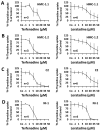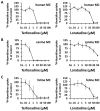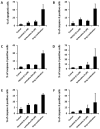H1-receptor antagonists terfenadine and loratadine inhibit spontaneous growth of neoplastic mast cells
- PMID: 20570632
- PMCID: PMC4337971
- DOI: 10.1016/j.exphem.2010.05.008
H1-receptor antagonists terfenadine and loratadine inhibit spontaneous growth of neoplastic mast cells
Abstract
Objective: In mast cell (MC) neoplasms, clinical problems requiring therapy include local aggressive and sometimes devastating growth of MCs and mediator-related symptoms. A key mediator of MCs responsible for clinical symptoms is histamine. Therefore, use of histamine receptor (HR) antagonists is an established approach to block histamine effects in these patients.
Materials and methods: We screened for additional beneficial effects of HR antagonists and asked whether any of these agents would also exert growth-inhibitory effects on primary neoplastic MCs, the human MC line HMC-1, and on two canine MC lines, C2 and NI-1.
Results: We found that the HR1 antagonists terfenadine and loratadine suppress spontaneous growth of HMC-1, C2, and NI-1 cells, as well as growth of primary neoplastic MCs in all donors tested (human patients, n = 5; canine patients, n = 8). The effects of both drugs were found to be dose-dependent (IC(50): terfenadine, 1-20 μM; loratadine, 10-50 μM). Both agents also produced apoptosis in neoplastic MCs and augmented apoptosis-inducing effects of two KIT-targeting drugs, PKC412 and dasatinib. The other HR1 antagonists (fexofenadine, diphenhydramine) and HR2 antagonists (famotidine, cimetidine, ranitidine) tested did not exert substantial growth-inhibitory effects on neoplastic MCs. None of the histamine receptor blockers were found to modulate cell-cycle progression in neoplastic MCs.
Conclusions: The HR1 antagonists terfenadine and loratadine, in addition to their antimediator activity, exert in vitro growth-inhibitory effects on neoplastic MCs. Whether these drugs (terfenadine) alone, or in combination with KIT inhibitors, can also affect in vivo neoplastic MC growth remains to be determined.
Copyright © 2010 ISEH - Society for Hematology and Stem Cells. Published by Elsevier Inc. All rights reserved.
Figures








References
-
- Valent P. Biology, classification and treatment of human mastocytosis. Wien Klin Wochenschr. 1996;108:385–397. - PubMed
-
- Escribano L, Akin C, Castells M, Orfao A, Metcalfe DD. Mastocytosis: current concepts in diagnosis and treatment. Ann Hematol. 2002;81:677–690. - PubMed
-
- Valent P, Akin C, Sperr WR, et al. Diagnosis and treatment of systemic mastocytosis: state of the art. Br J Haematol. 2003;122:695–717. - PubMed
-
- Akin C, Metcalfe DD. Systemic mastocytosis. Annu Rev Med. 2004;55:419–432. - PubMed
Publication types
MeSH terms
Substances
Grants and funding
LinkOut - more resources
Full Text Sources
Other Literature Sources
Miscellaneous

